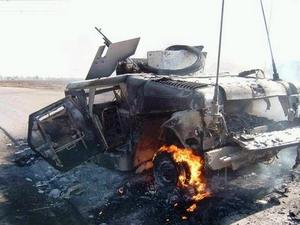Countering IEDsSwiss institute developed IED Zapper
IEDs kill and injure more American and coalition soldiers in Afghanistan than any other weapons insurgents employ; differences in terrain and IED design, where the primary detonator may be constructed of plastic to circumvent metal detectors, make military robots by Foster-Miller, iRobot, and Black-I Robotics not always effective; researchers now suggest detonating hidden IEDs from afar by using an electromagnetic pulse

Humvee destroyed by an IED // Source: monclovitas.com
Swiss technology institute EPFL has designed an electromagnetic weapon capable of safely exploding improvised explosive devices (IEDs) from twenty-five meters away.
Working alongside Colombia and Los Andes universities, the institute has been investigating for the past two years how to disarm the explosive devices left behind by guerilla groups in Colombia and insurgents in Afghanistan and Iraq.
The time-consuming process of sending robots to tackle the preferred terror weapon of choice in these regions has spurred research for alternative means of disarming IEDs. Because of differences in terrain and IED design, where the primary detonator may be constructed of plastic to circumvent metal detectors, military robots by Foster-Miller, iRobot, and Black-I Robotics may not always be the best choice.
Since IEDs are often only shielded by plastic and have circuitry susceptible to electromagnetic pulse overrides, the ray gun developed by EPFL has the ability to swamp the electronics inside with radio-wave-induced currents, forcing the IED to detonate before being triggered by the unsuspecting.
Once the IED has been discovered, the system generates a sequence of fast broad-spectrum electromagnetic pulses of intense radio waves at up to 1GHz in the desired direction. Professor Farhad Rachidi and his team have been refining the design over the years and have been able to work out optimal bandwidths to combat IEDs typically used in Colombia and Afghanistan.
The technology is being formatted into a more robust, portable prototype, which the team imagines it could be commercially viable within five years.
